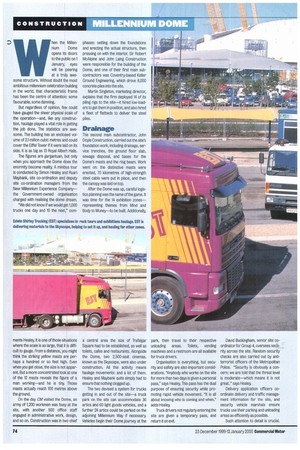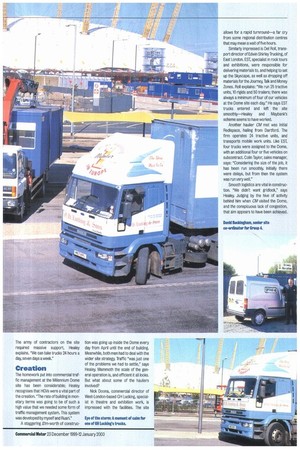D hen the Millen
Page 76

Page 77

If you've noticed an error in this article please click here to report it so we can fix it.
nium Dome opens its doors to the pubfic on 1 January, eyes will be peering at a truly awe some structure. Without doubt the most ambitious millennium celebration building In the world, that characteristic frame has been the centre of attention: some favourable, some damning.
But regardless of opinion, few could have gauged the sheer physical scale of the operation—and, like any construction, haulage played a vita/ role in getting the job done. The statistics are awesome. The building has an enclosed volume of 2.4 million cubic metres and could cover the Eiffel Tower if it were laid on its side. It is as big as 13 Royal Albert Halls.
The figures are gargantuan, but only when you approach the Dome does the enormity become reality A minibus tour is conducted by Simon Healey and Ruari Maybank, site co-ordination and deputy site co-ordination managers from the New Millennium Experience Company— the Government-owned organisation charged with realising the dome dream.
'We did not know if we would get 1,000 trucks one day and 10 the next,' corn ments Healey. It is one of those situations where the scale is so large, that it is difficult to gauge. From a distance, you might think the striking yellow masts are perhaps a hundred or so feet high. Even when you get close, the size is not apparent. But a more concentrated look at one of the 12 masts reveals the figure of a man working—and he is tiny Those masts actually reach 100 metres above the ground.
On the day CM visited the Dome, an army of 1,200 workmen was busy at the site, with another 500 office staff engaged in administrative work, design, and so on. Construction was in two chief phases: setting down the foundations and erecting the actual structure, then pressing on with the interior. Sir Robert McAlpine and John Laing Construction were responsible for the building of the Dome, and one of their first main subcontractors was Coventry-based Keller Ground Engineering, which drove 8,000 concrete piles into the site.
Martin Singleton, marketing director, explains that the firm deployed 14 of its piling rigs to the site—it hired low-loaders to get them in position, and also hired a fleet of flatbeds to deliver the steel
Drainage
The second main subcontractor, John Doyle Construction, carried out the site's foundation work, including drainage, service trenches, the ground floor slab, sewage disposal, and bases for the Dome's masts and the ring beam. Work went on: the distinctive masts were erected, 70 kilometres of high-strength steel cable were put in place, and then the canopy was laid on top.
After the Dome was up, careful logistics planning was the name of the game. it was time for the 14 exhibition zones— representing themes from Mind and Body to Money—to be built. Additionally, a central area the size of Trafalgar Square had to be established, as well as toilets, cafes and restaurants. Alongside the Dome, two 2,500-seat cinemas, known as the Skyscape, were also under construction. All this activity means haulage movements: and a lot of them. Healey and Maybank quite simply had to ensure that nothing clogged up.
The two devised a system for trucks getting in and out of the site—a truck park on the site can accommodate 36 artics and 60 light goods vehicles, and a further 24 artics could be parked on the adjoining Millennium Way if necessary. Vehicles begin their Dome journey at the park, then travel to their respective unloading areas. Toilets, vending machines and a restroom are all available for truck drivers.
Organisation is everything, but security and safety are also important considerations. "Anybody who works on the site for more than two days is given a personal pass," says Healey. This pass has the dual purpose of ensuring security while promoting rapid vehicle movement. "it is all about knowing who is coming and when," adds Healey.
Truck drivers not regularly entering the site are given a temporary pass, and return it on exit. David Buckingham, senior site coordinator for Group 4, oversees security across the site. Random security checks are also carried out by antiterrorist officers of the Metropolitan Police. "Security is obviously a concern; we are told that the threat level is moderate—which means it is not great, says Healey.
Delivery application officers coordinate delivery and traffic management information for the site, and security vehicle marshals ensure trucks use their parking and unloading areas as efficiently as possible.
Such attention to detail is crucial. The army of contractors on the site required massive support, Healey explains. We can take trucks 24 hours a day, seven days a week."
Creation
The homework put into commercial traffic management at the Millennium Dome site has been considerable; Healey recognises that FIG Vs were a vital part of the creation. "The rate of building in monetary terms was gong to be of such a high value that we needed some form of traffic management system. This system was developed by myself and Ruari."
A staggering Dm-worth of construc tion was going up inside the Dome every day from April until the end of building. Meanwhile, both men had to deal with the wider site strategy Traffic "was just one of the problems we had to settle," says Healey Mammoth the scale of the general operation is, and efficient it all looks. But what about some of the hauliers involved?
Nick Doona, commercial director of West-London-based GH Lucking, specialist in theatre and exhibition work, is impressed with the facilities, The site allows for a rapid turnround—a far cry from some regional distribution centres that may mean a wait of five hours.
Similarly impressed is Del Roll. transport director of Edwin Shirley Trucking, of East London. EST, specialist in rock tours and exhibitions, were responsible for delivering materials to, and helping to set up the Skyscape, as well as dropping off materials for the Journey Talk and Money Zones. Roll explains: "We run 25 tractive units, 10 rigids and 50 trailers; there was always a minimum of four of our vehicles at the Dome site each day." He says EST trucks entered and left the site smoothly—Healey and Maybank's scheme seems to have worked.
Another haulier CM met was Initial Redispace, hailing from Dartford. The firm operates 24 tractive units, and transports mobile work units. Like EST, four trucks were assigned to the Dome, with an additional four or five vehicles on subcontract. Cohn Taylor, sales manager, says: "Considering the size of the job, it has been run smoothly. Initially there were delays, but from then the system was run very well."
Smooth logistics are vital in construction. "We didn't want gridlock," says Healey. Judging by the hive of activity behind him when CM visited the Dome, and the conspicuous lack of congestion, that aim appears to have been achieved.




















































































































































